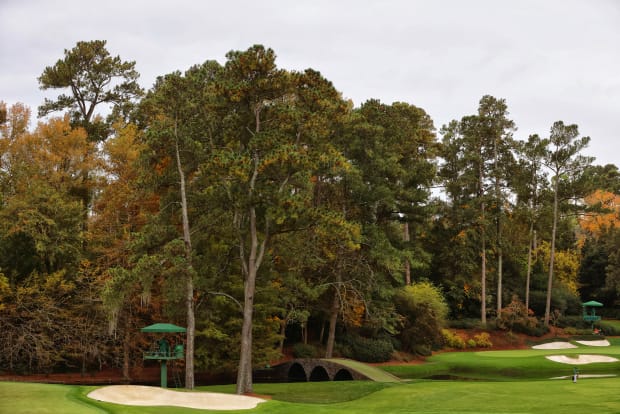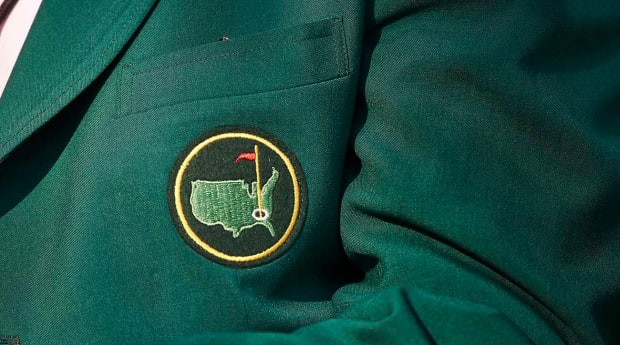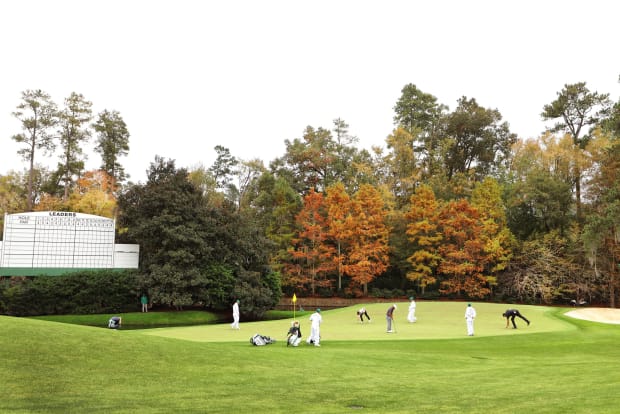The Masters is loath to change, but this year, it has a chance to evolve in ways that address these turbulent times.
From the moment Augusta National pushed this year’s Masters back from April to November, golf fans wondered how the course would look in the fall. Part of the Masters’ appeal is the illusion of timelessness. Augusta National is the only course that hosts a men’s major every year; most golf fans can recognize its most famous holes instantly. Egg salad and pimento cheese sandwiches cost $1.50. Fans are called patrons. Champions wear the same green jacket that Hogan, Nelson, Palmer and Nicklaus wore, but only the reigning winner gets to take the jacket off the grounds. And the azaleas are always in bloom.
This Masters was supposed to begin as a celebration of the recent past: Tiger Woods’s winning the 2019 title. Now? There will be no fans due to COVID-19 and social distancing. The Masters is golf’s greatest TV draw, but this year its last two rounds will go up against college and pro football. (The final round is scheduled to end by 2:45 p.m. on Nov. 15—giving CBS time before its 4:05 NFL broadcasts, but overlapping with the 1 p.m. games.)
Woods had chosen his Champions Dinner menu—steak and chicken fajitas, sushi and sashimi—before the Masters was postponed; he ended up eating that same meal, as scheduled on April 7, with his family at home instead. As weird as that must have felt, the actual Masters will feel weirder. Woods has talked about “the new normal” all summer, with no galleries following the players. But at Augusta players don’t just get adrenaline from the cheers—they get information.
“You just have all those roars that would go up [that] somebody did something somewhere. . . . Obviously, the pairings, we know who that would probably be. We’re not going to have any of that now,” Woods said this summer. “So scoreboard-watching and trying to figure out what’s going on, there aren’t a lot of big leaderboards out there, so that will be very different.”

Woods recalled playing Augusta National for the first time in 1995, as a guest: “Seeing it with no fans, it was eye-opening how much room there is. When you put 40,000 people on such a small piece of property, it gets—I know there’s no rough, but it gets confined. But this will be very different.”
Like everything else at Augusta National, though, this will be only as different as the members want it to be. Dogwoods will not be in bloom, and many leaves will be orange instead of green, but those pink-and-white azaleas? You might see them: Encore azaleas bloom in spring, summer and fall. The club could also mix in camellias for more color.
“They have all kinds of magic they can work,” says Leah Bryant, a horticulture instructor at Augusta Technical College. “It’s like Disneyland.”
One way or another, the course will look fantastic. It always does. But the floral question raises a larger one: In a year of radical change, what is the role of a place that always seems the same?
***
COVID-19 and social justice have dominated 2020 headlines, with climate change making a strong and necessary push. The world of golf has done a better job of navigating 2020 than many might have expected. The PGA Tour was the first major U.S.-based sports league to resume play after the pandemic hit, and the first to successfully finish its season.
A widespread protest would be hard to pull off in golf, where the players are essentially independent contractors, and there was never any serious talk of a walkout. But several stars, including Phil Mickelson, Justin Thomas, Brooks Koepka and Jon Rahm, posted black squares on Instagram on June 2 to support Blackout Tuesday.
Augusta National has tried, like many U.S. institutions, to quietly change its ways without fully acknowledging its racist past. Autocratic ANGC cofounder Clifford Roberts famously declared that as long as he was there, the players would be white and the caddies would be Black; he is still revered at the grounds. The club has progressed—one of current chairman Fred Ridley’s first moves was creating and hosting the final round of the Augusta National Women’s Amateur last year—but it still values exclusivity above almost everything else.
The club generally treats patrons and players exceptionally well, but on its own terms. The last time the Masters was held after a long, unplanned layoff was 1946; the previous three tournaments were canceled due to World War II. In the third round that year, somebody changed the tee times without telling leader Herman Keiser, who had to scramble to get to No. 1. He was also assigned a new caddie. That day, a sportswriter told him he was playing too slowly—while he was still playing. Keiser was irritated, but there was only so much he could say: The writer, Grantland Rice, had been a member of Augusta National since its inception in 1933.

ANGC has long used its power for two primary purposes: to stage what is, by far, the best-run golf tournament in the world and to keep that power in the hands of the elite. If all you care about is golf, this formula works. But every other league—including the staid NFL—has acknowledged that 2020 is different. The simple act of consuming the news has caused millions to reflect and to ask the essential question: How can we be better? If the most exciting development this year is that Bryson DeChambeau can, indeed, hit a 350-yard draw on the par-5 13th, then the club will have failed.
One reason pros love Augusta National is that it is perfectly manicured—with a SubAir pipe system under the greens and groundskeepers who leave no blade of grass untended. But golf started long before modern sprinkler systems. There is simply nothing “wrong” with a baked-out fairway; a dry, fast course encourages a greater variety of shots. Augusta National was designed to allow golfers to use the ground game, but with the course’s constant watering, it is pretty much impossible now. Worst of all: Weekend golfers watching the Masters expect their home courses to match ANGC’s conditions. It helps perpetuate golf as an expensive, environmentally destructive sport. Golf can be better, and Augusta National can help lead the way by not making the course look so pristine.

The social justice movement is tricky terrain, but if any sports institution has an obligation to support it, certainly Augusta National does. The club’s history with regard to race is famously appalling—even worse than the golf world as a whole. Bad enough that the PGA Tour did not rescind its white-only clause until 1961; no Black player competed in the Masters until Lee Elder in 1975. The club did not add a Black member until 1990 or female members until 2012, and did so each time only after public pressure. When club chairman Billy Payne famously chastised Tiger Woods for his infidelities, it was a wince-worthy moment: a white chairman scolding the event’s only Black winner, as though Woods was the only great golfer who ever cheated on his wife.
A place cannot celebrate its history this much and ignore such a significant chapter. If Clemson football players can wear Black Lives Matter stickers on their helmets, then Augusta National can be proactive in its support, too. It would shine a light on the club’s past, but it would also be one of the most powerful statements of the year.
St. Andrews fairly calls itself the Home of Golf, but it is more like its childhood home: a place the sport visits for the Open every few years, to remember its roots. Augusta National is golf’s gathering place. The club traditionally makes public announcements the week of the Masters; this year is a great opportunity to offer some bold ones, such as spelling out BLACK LIVES MATTER on the same grass in Amen Corner where fans watched Woods take a share of the lead last spring. It is one thing for the NBA, which is largely Black, to support BLM; what if Augusta National did?
And in the long term, how about a small museum, open to the public year-round featuring an unvarnished look at the club’s history? Celebrate Horton Smith’s two Masters titles but also point out that, as PGA president, he reneged on his 1948 deal to open the Tour to Black players. Give Roberts full credit for building the Masters, but acknowledge he was on the wrong side of history.
Tell people the club’s land used to belong to Fruitland Nurseries, a company built by immigrants. Celebrate the racial breakthroughs of Elder and Woods. Make the course a model of environmental stewardship.
This is all so far from what we expect that it is hard to envision. But Augusta National could do it as easily as it can make azaleas bloom in November. This is exactly the wrong time to pretend that everything is—and should be—the same as it ever was.
More 2020 Masters Coverage
• Previewing the 2020 Masters at an Empty Augusta National
• Daily Cover: A Masters Unlike Any Other
• Five Dark Horse Candidates That Could Win the 2020 Masters